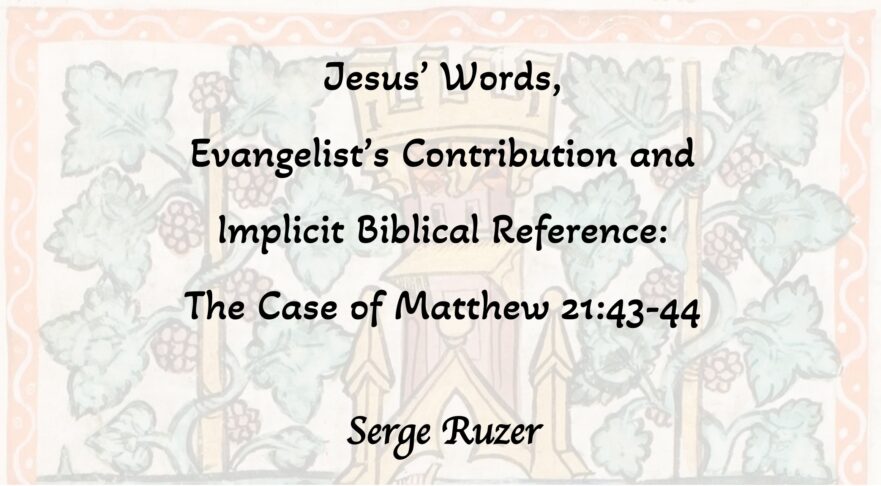How to cite this article: Serge Ruzer, “Jesus’ Words, Evangelist’s Contribution and Implicit Biblical Reference: The Case of Matthew 21:43-44,” Jerusalem Perspective (2024) [https://www.jerusalemperspective.com/28340/].
This article belongs to the collection Ashrech Ziqnati (Blessed Are You, My Old Age): Studies in Honor of David Bivin’s 85th Birthday.

It is my pleasure to participate in the volume honoring David Bivin, whose decades-long research has contributed greatly to our understanding of the developments underlying the Synoptic tradition. David’s analysis is always an example of attentiveness to the text and penchant for exactness of the solutions offered. Below, I will try to follow the former, though as for the latter, my short essay clearly does not meet the bar. However, if in the final account the definite answer eludes us, even the tentative suggestions may have some merit.
Matthean Contributions to the Parable of the Vineyard and the Tenants
The parable of the vineyard and the tenants in Matt. 21:33-46, usually seen as referring to Isa. 5:1-7, where the vineyard of the Lord imagery is explained as representing Israel,[29] has Synoptic parallels in Mark 12:1-12 and Luke 20:9-19.[30] All three versions place the parable in the context of Jesus’ cleansing the Temple and thus his conflict with the Temple establishment.[31] The evil tenants of the parable are thus obviously intended to signify the priestly leaders. It is only Matthew who cares to include Pharisees among the addressees of Jesus’ invective (Matt. 22:45): “When the chief priests and the Pharisees heard his parables, they perceived that he was speaking about them.”[32] This may be ascribed to the well-known Matthean tendency to highlight the motif of Jesus’ conflicts with Pharisees, a tendency interpreted as a sign of Matthew’s closeness to Pharisaic circles,[33] or, alternatively, a fait accompli of estrangement.[34]

This inclusion of the Pharisees in itself indicates the secondary character of Matthew’s additions to the parable of the vineyard and the tenants, but it does not end here: Matthew is the only evangelist who makes Jesus to proclaim: “Therefore I tell you, the kingdom of God (ἡ βασιλεία τοῦ Θεοῦ) will be taken away from you and given to a nation (ἔθνει) producing the fruits of it” (Matt. 21:43). One notes that the motif of the kingdom in the context of this parable is peculiar to Matthew, who appeals to it also in the preceding passage, with Jesus telling to the chief priests: “Truly, I say to you, the tax collectors and the harlots go into the kingdom of God before you” (Matt. 21:31).
Premium Members and Friends of JP must be signed in to view this content.
If you are not a Premium Member or Friend, please consider registering. Prices start at $5/month if paid annually, with other options for monthly and quarterly and more: Sign Up For Premium
Conclusion
The backdrop Qumranic evidence combined with the likely biblical allusion, discerned in the addition to the Wicked Tenants parable (and supported by the evidence from 1 Peter), give more weight to a non-ethnic interpretation of Matthew’s editorial intent.
Additional Note: One notes that the Qumranic evidence is conspicuously lacking the kingdom motif. Would it be still reasonable to suggest that the priests at Qumran applied Exod. 19:6 to themselves and their community? While this application might be expected, I have not managed to locate in the Scrolls any explicit reference to such a perception.
- [1] See, for example, D. Flusser, ”The Kingdom of Heaven,” in idem (with R. S. Notley), The Sage from Galilee: Rediscovering Jesus’ Genius (Grand Rapids, Mich., Eerdmans, 2007), 76-96. ↩
- [2] E.g., Luke 17:21 (“the kingdom is within you/in your midst”), cf. m. Ber. 3.5. See previous note. ↩
- [3] E.g. Matt. 13:36-46, where the kingdom is described with reference to Daniel 12 picture of general resurrection. ↩
- [4] Dan. 7:18. Cf. Acts 1:3-6, where this intrinsic link is spelled out. ↩
- [5] See, for example, W. C. Allen, A Critical and Exegetical Commentary on the Gospel according to Saint Matthew (Piscataway, NJ: Gorgias Press, 2010), 232. ↩
- [6] U. Luz, The Theology of the Gospel of Matthew (Cambridge: Cambridge University Press, 1995), 119-120. ↩
- [7] D. Flusser, “Anti-Jewish Sentiment in the Gospel of Matthew,” in Judaism of the Second Temple Period: Jewish Sages and Their Literature (translated by A. Yadin, Foreword by D. Bivin, Grand Rapids, Mich. and Jerusalem: Eerdmans and Magnes, 2009), 351-353. ↩
- [8] See, for example, Isaiah 1. Cf. Dan 7.17, where the kingdom is promised to taken from the chain of evil empires and given to “the people of the saints of the Most High,” meaning to Israel (or its holy remnant). ↩
- [9] An analysis in Jerusalem Perspective discerns in Matthew (similarly to Josephus) telling pro-Roman sentiments (see JP Staff Writer, “Evidence of Pro-Roman Leanings in the Gospel of Matthew” Jerusalem Perspective (2024) [https://www.jerusalemperspective.com/28170/]), but in my view it is still a far cry from presenting the ethnos of the Empire as a new covenant people. ↩
- [10] This is the solution embraced, inter alia, in Davies and Allison, Matthew, 190 (with a caveat that there is nothing in the passage about the final dismissal of the Jews). See also A. M. Gale, “The Gospel According to Matthew,” in A.-J. Levine and M.Z. Brettler (eds.), The Jewish Annotated New Testament (New York: Oxford University Press, 2011), 39. ↩
- [11] 1 Pet. 2.9; 1 Clem. 29.3; Justin, Dial. 24.2; 63.2; 123.1. To quote O. Scarsaune (“Ethnic Discourse in Early Christianity,” in J. C. Paget and J. Lieu (eds.), Christianity in the Second Century: Themes and Developments [Cambridge: Cambridge University Press, 2017], 251), “In early Christian literature, ethnos in the singular is used most often about the Jewish people, on rare occasions about the Christians as a people.” Even in the first half of the fourth century, Aphrahat (Dem. 17.10) characteristically described the Christians as coming from the nations (plural: ܥܡܡܸܐ) as distinguished from the Israeli nation (sing.). ↩
- [12] “Prophet” being a Matthean designation for Jesus, so far as the crowds are concerned, see J. C. R. Cousland, The Crowds in the Gospel of Matthew (Leiden: Brill, 2002), 208. ↩
- [13] H. Basser and M. B. Cohen, The Gospel of Matthew and Judaic Traditions: A relevance-based Commentary (Leiden: Brill, 2015), 555. ↩
- [14] Cf. the strategy of Acts insisting on the great success of the Jesus-centered message among the land of Israel Jews. ↩
- [15] Cousland, Crowds in Matthew, 33. ↩
- [16] Ibid., 35. ↩
- [17] Joshua Tilton suggested (personal communication) that Matthew could mean here a general backdrop of popular support for Jesus’ prophetic status, without claiming that the crowd in question witnessed the polemical exchange with the priests. They are thus not said to side with the proverbial statement that Israel will be replaced – no problem in need of solution. It is definitely an interesting interpretation regarding a possible historical setting of the episode. Focusing on the Gospel narrative strategies, however, I find it not convincing enough, since when Matthew speaks about “multitudes,” these are usually highly involved crowds, which are actually present at the specific points of the story, see Matt. 4:25, 7:28, 8:1, 9:8,33, 12:23, 13:2, 14:13, 19:2, 21:9-11, 22:33. ↩
- [18] See Luz, Matthew, 119-120. ↩
- [19] Cf. the suggestion in Konradt, Matthew, 325, that those were non-residents of Jerusalem who could have built-in animosity to the priestly establishment. ↩
- [20] Liddell and Scott’s An Intermediate Greek-English Lexicon (Oxford: The Clarendon Press, 1989), p. 226. Cf. the LXX usage of ethnos in, e.g. Gen. 20:4; Deut. 1:28, 2:9. In the two latter cases, the Hebrew text has עַם (‘am) with the meaning “large group”, in the former the Hebrew has גּוֹי (gōy) relating to an individual. ↩
- [21] Pace, e.g., Allen, Matthew, 232, who believes that the issue here is the eschatological kingdom: “he (Matthew) has throughout the Gospel employed this term for the eschatological kingdom which Christ announced, and which was to be inaugurated when the Son of Man came upon the clouds of heaven, it would have been unsuitable here. For that kingdom had never been the possession of the Jewish rulers, and could not be taken from them.” ↩
- [22] Cf., e.g., Konradt, Matthew, 321. ↩
- [23] N. Perrin and D. C. Duling, The New Testament: An Introduction (San Diego et al.: Harcourt Brace Jovanovich, 1982), 377. ↩
- [24] See discussion in B. D. Ehrman, The New Testament: A Historical Introduction to the Early Christian Writings (Oxford, New York et al.: Oxford University Press, 2000), 397-401. ↩
- [25] The same goes for Rev 1:6. ↩
- [26] See Konradt, Matthew, 324. ↩
- [27] E.g., Damascus Documents 6; 4QFlorilegium 1; 4QMMT. ↩
- [28] 1QS 1.7-10: “to welcome all those who freely volunteer to carry out God’s decrees 8 into the covenant of kindness; in order to be united in the counsel of God and walk in perfection in his sight, complying with all 9 revealed things concerning the regulated times of their stipulations; in order to love all the sons of light, each one 10 according to his lot in God’s plan, and to detest all the sons of darkness, each one in accordance with his guilt 11 in God’s vindication.” ↩
- [29] See discussion in J. Blenkinsopp, Isaiah 1-39: A New Translation with Introduction and Commentary, The Anchor Bible (New York et al.: Doubleday, 2000), 206-208. ↩
- [30] Dependence on Mark is usually suggested here, see W. D. Davies and D. C. Allison, A Critical and Exegetical Commentary on the Gospel According to Saint Matthew (3 vols.; Edinburgh: T&T Clark, 1988-1997), 3:175. ↩
- [31] See, for example, M. Konradt (M. E. Boring, translator) The Gospel According to Matthew: A Commentary (Waco, Texas: Baylor University Press, 2020), 321. ↩
- [32] Cf. Luke 20:19: “The scribes and the chief priests tried to lay hands on him….” ↩
- [33] B. Repschinski, “Taking on the Elite: The Matthean Controversy Stories,” Society of Biblical Literature Seminar Papers (Atlanta: SBL Press,) 1999, 1-23; A. J. Saldarini, Matthew’s Jewish-Christian Community (Chicago: The University of Chicago Press, 1994). ↩
- [34] See A. J. Overman, Matthewʼs Gospel and Formative Judaism: The Social World of the Matthean Community (Minneapolis: Fortress Press, 1990); U. Luz, Studies in Matthew (Grand Rapids, MI: Eerdmans, 2005). ↩



